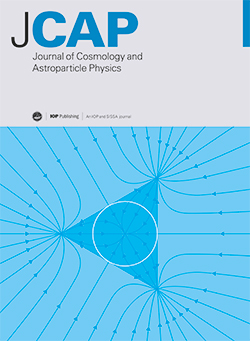Investigating primordial black hole accretion through cosmic optical depth
IF 5.9
2区 物理与天体物理
Q1 ASTRONOMY & ASTROPHYSICS
Journal of Cosmology and Astroparticle Physics
Pub Date : 2025-07-08
DOI:10.1088/1475-7516/2025/07/027
引用次数: 0
Abstract
Primordial black holes (PBH) accretion in the late Universe can lead to significant mass growth. A larger mass further accelerates the accretion radiation output for PBHs with initial masses greater than one solar mass, potentially leading to a stringent energy-dumping constraint derived from observations of the cosmic microwave background. The energy injected via PBH accretion is capable of ionizing and heating the intergalactic medium (IGM), ultimately affecting the optical depth of cosmic reionization and the 21-cm signal. This work investigates primordial black hole mass growth using the Bondi-Hoyle accretion model and accounts for additional ionization and heating induced by PBHs. We derive stringent PBH abundance limits using an upper limit on optical depth set by Planck 2018 CMB measurements. We find that accretion growth significantly strengthens late-time observational constraints for primordial black holes with initial masses ranging from several solar masses up to 104 solar masses. The PBH fraction of the Universe's unobserved mass content can be constrained to fPBH, ini ∼ 10-2 to 10-7 in this mass range, and when accounting for mass evolution our constraints can be strengthened by up to one order of magnitude. In addition, we show that PBH mass growth will lead to an observable impact on the predicted hydrogen 21-cm brightness temperature.通过宇宙光学深度研究原始黑洞吸积
宇宙晚期的原始黑洞(PBH)吸积可以导致显著的质量增长。更大的质量进一步加速初始质量大于一个太阳质量的PBHs的吸积辐射输出,可能导致从宇宙微波背景观测得出的严格的能量倾倒约束。通过PBH吸积注入的能量能够电离和加热星系间介质(IGM),最终影响宇宙再电离的光学深度和21厘米信号。本研究使用Bondi-Hoyle吸积模型研究了原始黑洞的质量增长,并解释了pbh引起的额外电离和加热。我们利用普朗克2018 CMB测量设定的光学深度上限,推导出严格的PBH丰度极限。我们发现,吸积增长显著增强了原始黑洞的后期观测约束,初始质量从几个太阳质量到104太阳质量不等。宇宙中未观测到的质量含量的PBH分数可以被限制在fPBH,在这个质量范围内为ini ~ 10-2到10-7,当考虑到质量演化时,我们的约束可以被加强到一个数量级。此外,我们还发现PBH质量的增长会对氢的21cm亮度温度产生明显的影响。
本文章由计算机程序翻译,如有差异,请以英文原文为准。
求助全文
约1分钟内获得全文
求助全文
来源期刊

Journal of Cosmology and Astroparticle Physics
地学天文-天文与天体物理
CiteScore
10.20
自引率
23.40%
发文量
632
审稿时长
1 months
期刊介绍:
Journal of Cosmology and Astroparticle Physics (JCAP) encompasses theoretical, observational and experimental areas as well as computation and simulation. The journal covers the latest developments in the theory of all fundamental interactions and their cosmological implications (e.g. M-theory and cosmology, brane cosmology). JCAP''s coverage also includes topics such as formation, dynamics and clustering of galaxies, pre-galactic star formation, x-ray astronomy, radio astronomy, gravitational lensing, active galactic nuclei, intergalactic and interstellar matter.
 求助内容:
求助内容: 应助结果提醒方式:
应助结果提醒方式:


